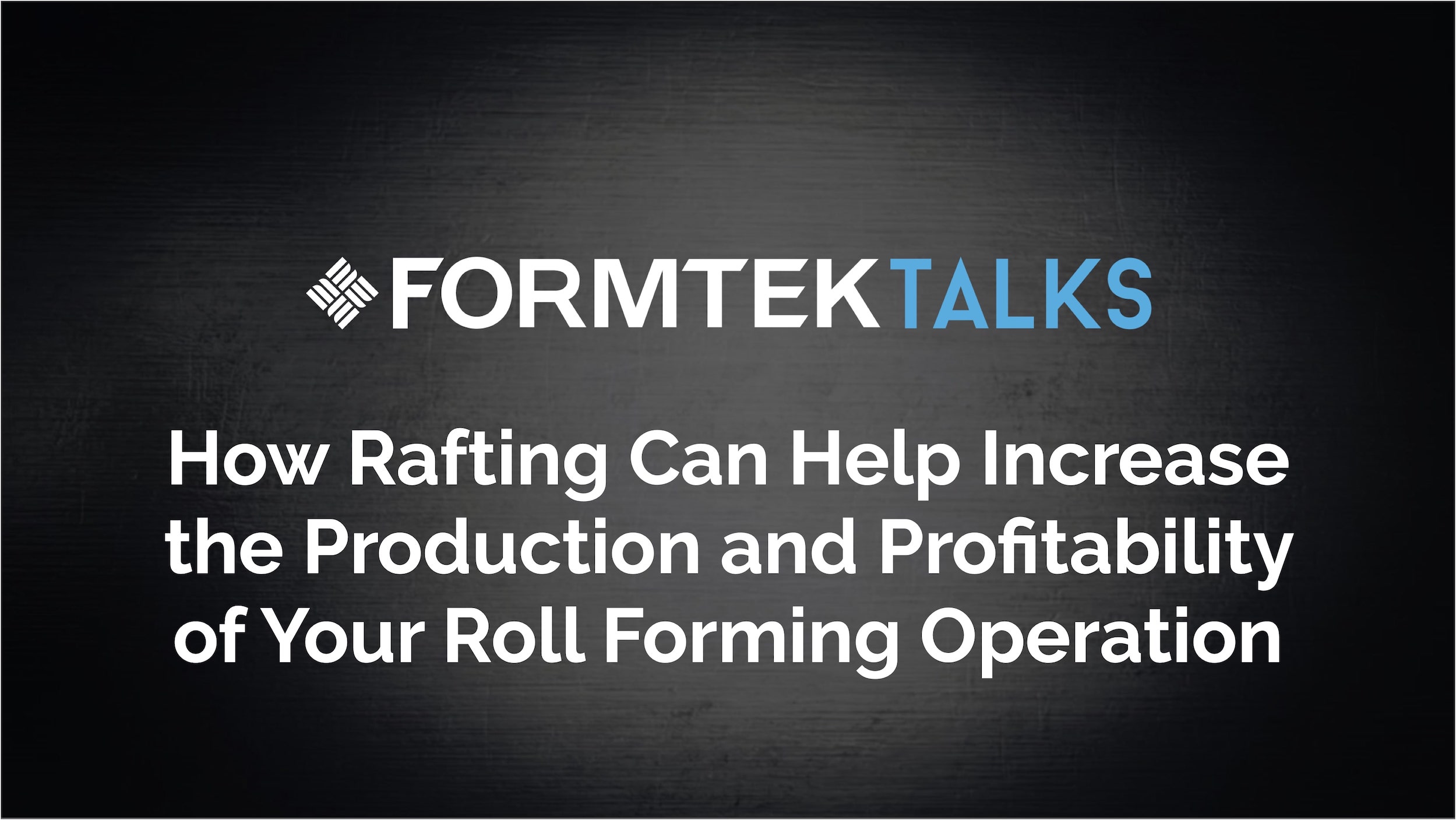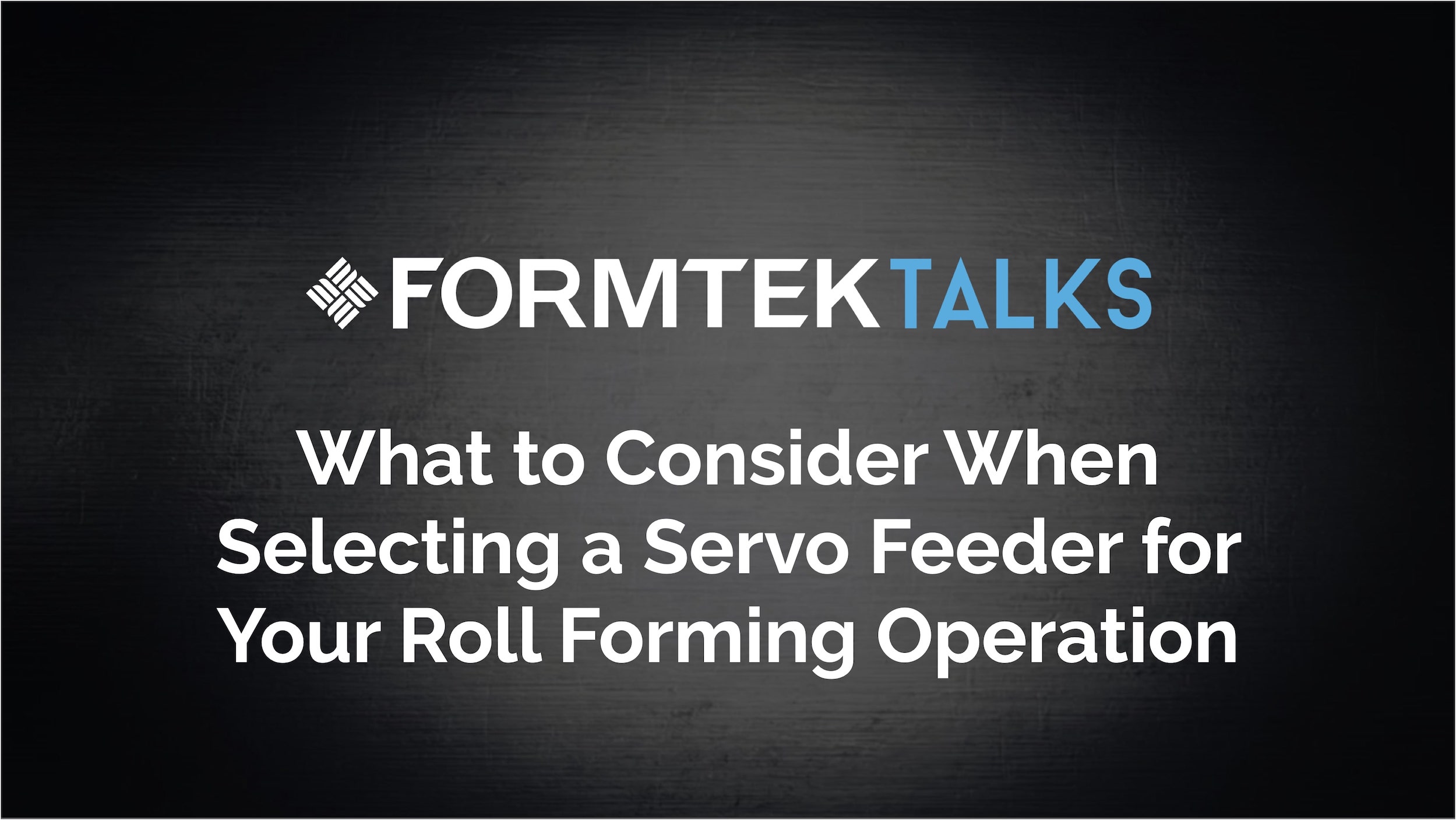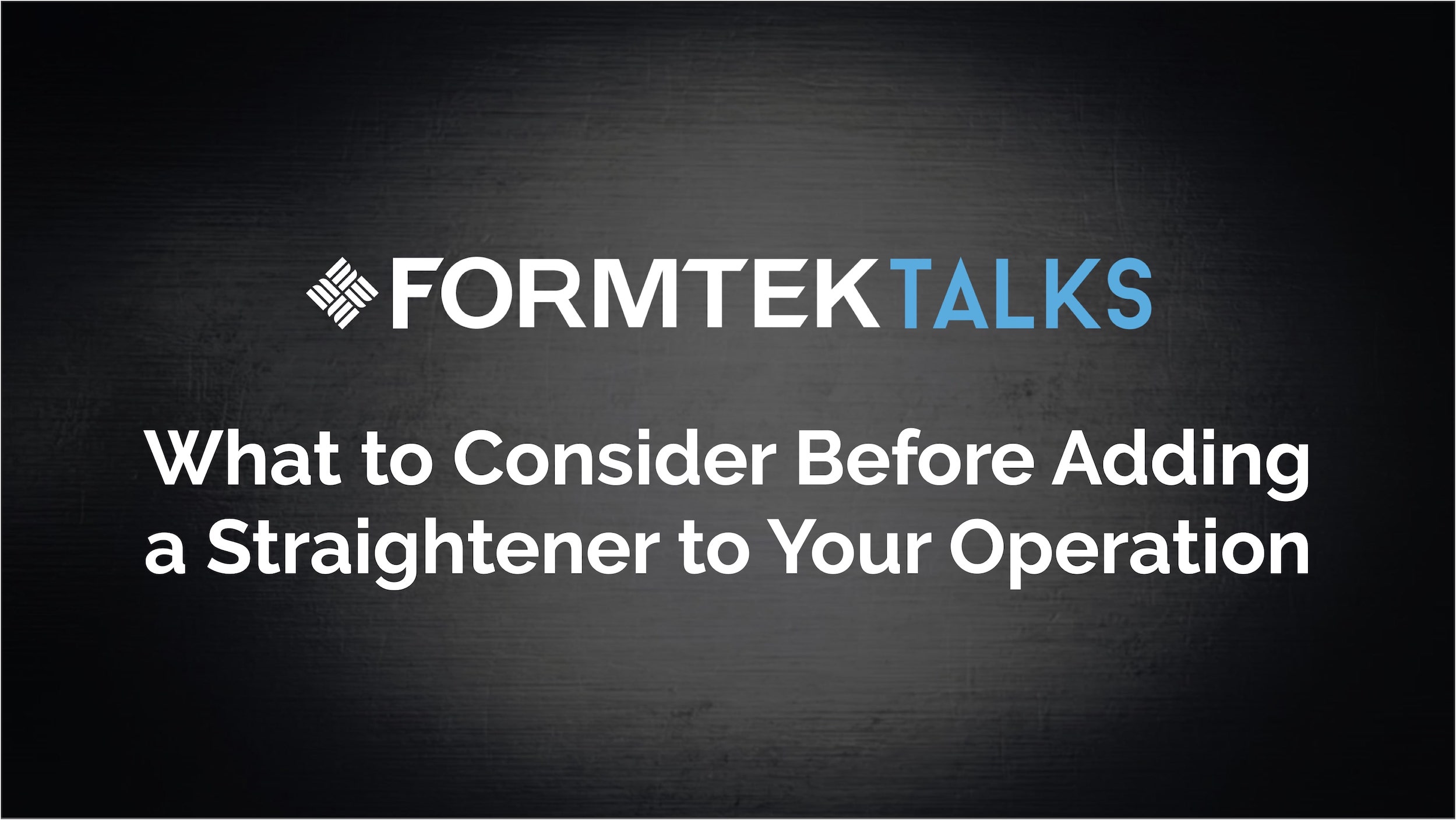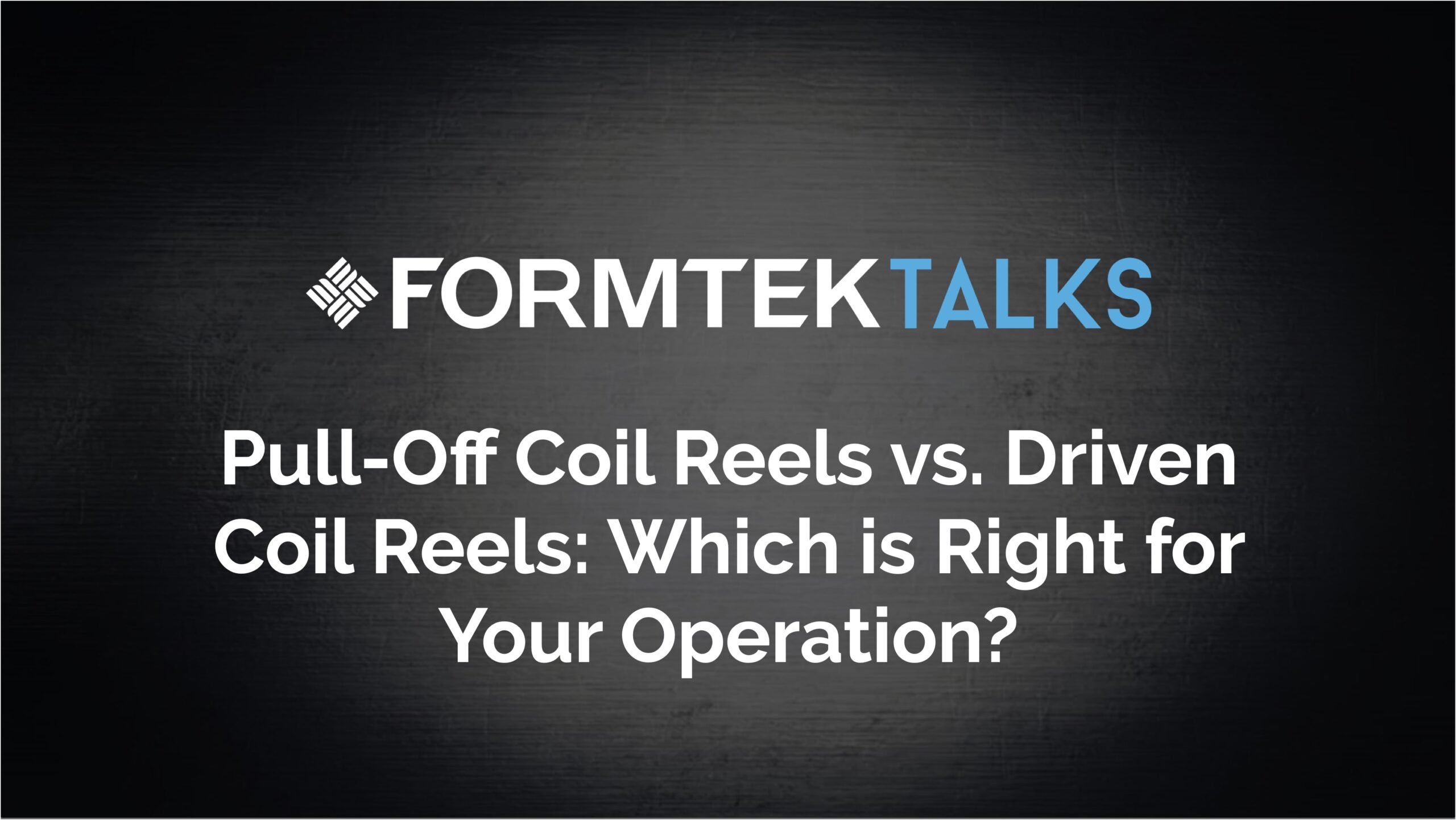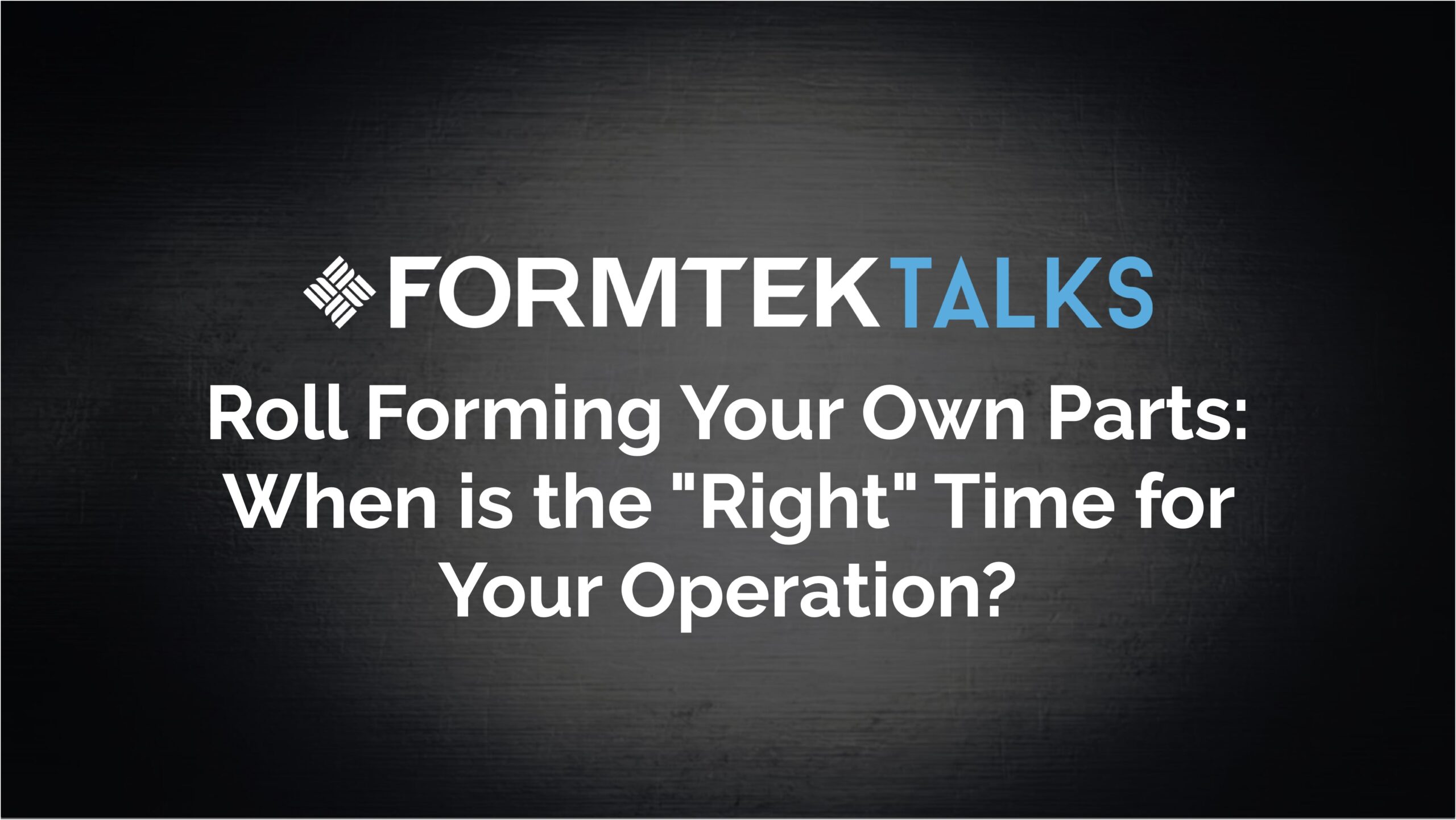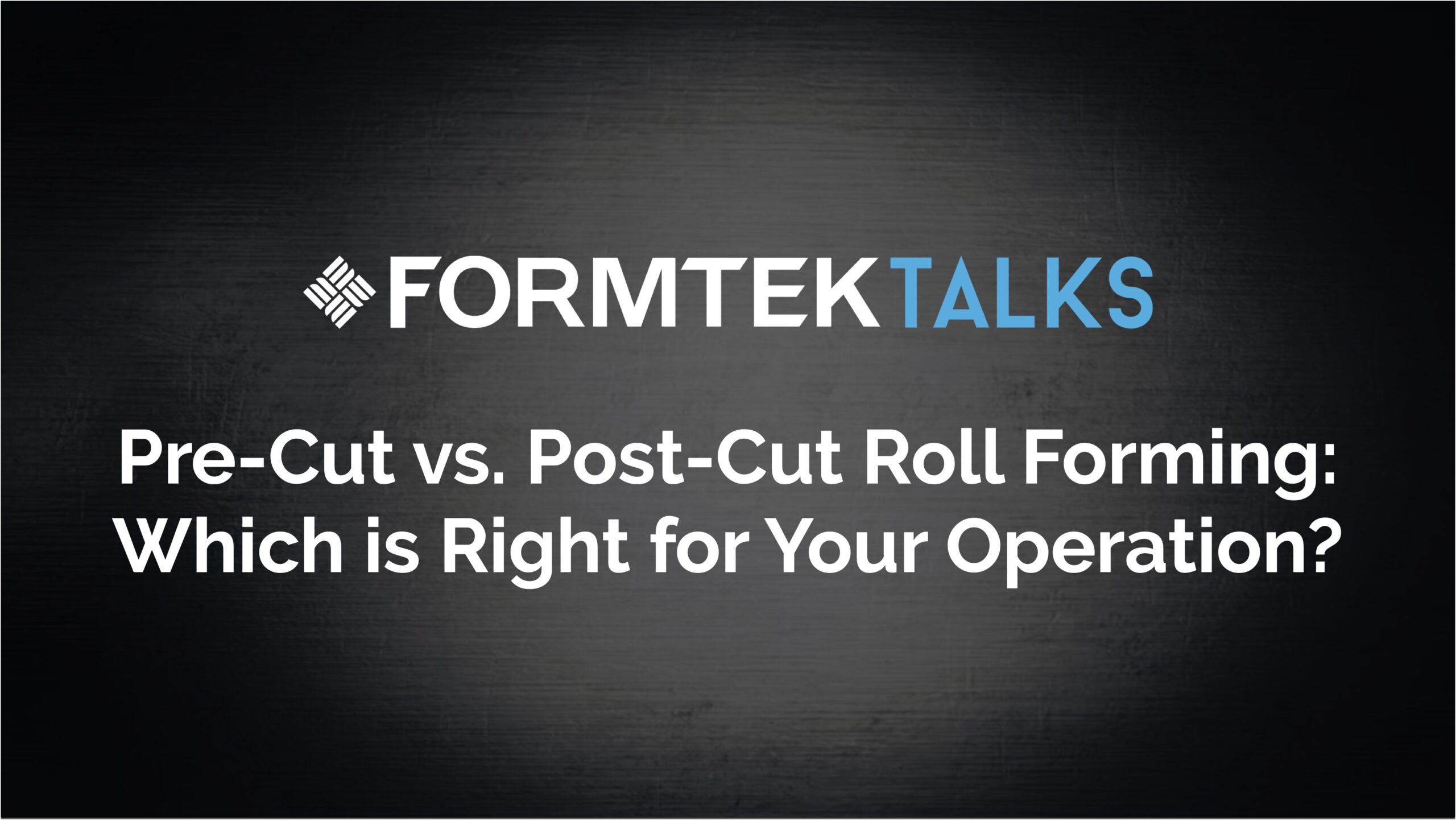Brian:
Hello, welcome to Formtek’s podcast. My name is Brian. We’re going to talk a little bit today about the different types of press styles used in the roll forming process for pre-notching cutoffs. Today, I have Paul Williams and Darren Muchnicki with us. We’re going to discuss these topics and see how we can proceed. Paul, why don’t you give us a rundown of the different types of presses out there that we use in the roll forming industry.
Paul:
Sure. Typically, there’s three styles of presses that we would typically use on a roll forming line. One is air slash pneumatic presses. Second one is hydraulic or third is mechanical presses. And each in those three categories, there’s different style presses. In the air pneumatic, a very common style press is a bladder style press where there’s a bladder in between the top plate and the movable ram. Or it would be we mount an air cylinder to the top of the ram, or as an under-driven gets pulled down from underneath. Hydraulic, same way. A hydraulic cylinder could be on the top. It can be on the bottom. And then mechanical presses could be where they have a mechanical crank and the crank could be on the bottom, which is an under-driven press, which is a very popular press in the roll forming industry or mechanical press that you would see in a regular stamping operation with a lot of OEM manufacturers-
Brian:
That they’ve adapted over into the roll forming process.
Paul:
Absolutely. Right. Just for ease.
Brian:
You can still use some of the big-name mechanical presses.
Paul:
Absolutely. And we do as well, especially in the pre-punching system.
Brian:
Okay. When would a customer consider one over the other? Or why would they consider one over the other?
Paul:
Typically, air presses are the most economical type presses for the type of tonnage you can get out of those. So as of a lower-cost type of scenario, an air press is the most economical way. A downside to air process is that depending on if their … in the case of a bladder style press, their tonnage rating is at 100 PSI at a half-inch stroke. So most bladder presses can go about three inches a stroke. More stroke on a bladder press, less tonnage you get. So if you have something where you have a blade type cutoff die, where you have multiple strokes-
Brian:
You typically have a very long stroke.
Paul:
Just because you have a 20-ton press you’re not actually getting 20 tons. If you use an air cylinder type for that, you may not be able to get that much tonnage out of that cylinder. So with any type of cylinder, a hydraulic or air, you’ll tend to get the full tonnage all the way through the stroke, but now you have a really big that you may not be able to actually do. Hydraulic presses, there’s a couple of different styles. We call them the HHP, which looks like an air press, but just has a hydraulic cylinder on there. And we also have an HX series which is where we mount a cylinder on a die. And this way we can do all kinds of different things-
Brian:
Custom work.
Paul:
Custom work because the cylinder doesn’t care which way we cut things, up, down, left, right, anything like that. So typically HHP press is maybe about double of an air press in the same tonnage range if everything’s apples to apples. When we get to the mechanical presses, the under-driven presses are fairly expensive compared to an air press and maybe a little bit more than our HHP standard hydraulic presses. And then when you get into the regular OEM mechanical presses type things, those can be somewhat cost-effective, especially for pre-punching for the bed size that you need and the stroke and strokes per minute. It comes down to a combination of some tonnage, the application we’re doing. There are certain applications we wouldn’t want to do in an air press that would need to do in a mechanical press or a hydraulic, depending-
Darren:
Like what?
Paul:
Any kind of forming.
Darren:
Right.
Paul:
So any kind of forming that [crosstalk 00:04:22]-
Darren:
Embossing.
Paul:
… form or emboss. We don’t want to do that in an air press because even though there’s typically bottom stop ram stops, you don’t want to bottom one of those presses out type of thing. And the speed of an air press is so fast that it could cause some issues in regards to some of that forming. So if it was a cutoff form where we’re going to go ahead and form up the tail end-
Brian:
Some tabs or something.
Paul:
Tabs so we don’t have to go to a secondary operation. We just take care of it all in the cutoff. We may look at a hydraulic press, self-contained hydraulic press, or a mechanical press.
Brian:
Okay. So, Darren, Formtek has several different types of mechanical presses that we build. Different tonnages I should say. They all seem to be what we call an underslung-driven press.
Darren:
Right.
Brian:
Why is that? Why did Yoder many years ago or Tishken many years ago develop these underslung presses, which are really only used in the roll forming industry?
Darren:
Yeah, primarily because they were quick, they were short stroked. The most stroke we have a six-inch higher tonnage, but for a 50-ton press, it was either a two-inch or a five-inch stroke or a two-inch and four-inch stroke, depending on what crank you had in there. So it was quick, but we don’t run these presses continuous. They run single stroke.
Brian:
That’s a good point.
Darren:
Sure we put a very good quality clutch and brake on it, but again, they’re single-stroked. If you have any … And they were fast enough. They would give you a good enough cut. And like Paul said, if you had to do a form or something in the end, you could still do it. Those were created well before hydraulic presses we’re around.
Paul:
Absolutely.
Darren:
So that was the only way you could do it. So it was only hydraulic and really air didn’t really come into play until about sometime in the late seventies, early eighties is about when air was around. If I remember correctly. So it was really just mechanical presses. And those were it for the roll form application. Now, do people use a stamping press for a cutoff? Sure. You can do that. And most times they’ll do it just because of bed length or if they’re going to put some extra … like do a die train so they’re punching a bunch of extra things in the cutoff and back up the part. They’ll do that.
Paul:
Or they had one sitting in the corner.
Darren:
Or they have one sitting in the corner. But if you have a … is an underslung press, can you use it as a pre-notch press? You can, but at that point, you’d really look at a stamping press, especially if you’re going to run it continuous-
Brian:
Because it’s a little overkill.
Darren:
It wants to run continuous. The stamping press wants to run continuous. It’s thinking of the product die. Sure you can do palm buttons and you can single stroke them, but it’s they want to run continuous. And there’s applications for it. Again, application-based.
Brian:
Right. Now, Paul, when we’re talking air or pneumatic presses and we have hydraulic presses, when we sell a system like that, the hydraulic obviously comes with its own hydraulic power pack. But with air, the customer has to have some type of device making the air. And is that usually part of somebody’s decision on buying because they got to … if you think about it, it’s stroking a lot through the day, you have to have a fairly large air compressor.
Paul:
In some cases, especially the … so typically we’ll go up to about 30 tons in an air press. Anything larger while you could do that with multiple bladders and things like that, the air consumption, especially the amount of stroke that you use could be quite, quite large and may require a customer to go ahead and buy a separate system.
Darren:
You remember the one customer had a 300-ton air pre-notch press and they had, I think that was about a six-inch pipe full of air going into it.
Brian:
That has to be pretty costly in terms of the compressor.
Darren:
But it was costly.
Paul:
Yeah, it was costly. And I’ve seen 100-ton presses, air presses-
Darren:
And they’re loud.
Paul:
… that are just loud, violent. Well, some of that goes into how they’re set up. So go into the question. Typically, going to that, we provide a little bit of how much can we feed that the bladders will generate depending on the stroke so they can have some kind of information to figure out if their current system in the plant will work that, or if they need a separate system. When it comes to the air presses, as Darren alluded to the noise. And typically, what I’ve found over all the years is that most of the time, the presses weren’t sized correctly for tonnage, for the application. So just because you have a 20-ton press, as I mentioned, their ratings on a bladder style press, let’s say, are 100 PSI, half-inch stroke. Oh, I have 20 tons. And this goes to a general statement of any process. Oh, let’s throw something in there requires 20 tons. Well, it’s not going to work well. So typically, they have the air presses sized wrong. And then with especially a bladder style press, the thought is, is that you want to go ahead and you have the bladder, you send a signal, the bladder expands. It sends the ram down. But you want to shut the air off. A lot of people have the air, no matter what PSI, going full bore all the way down to the ram stops. So all of a sudden you’re just getting a pow, pow, pow because it’s hitting the stops air going full bore. We actually want to shut that air off usually the inertia of the ram to go ahead and finish the cut.
Darren:
What brings the ram back up?
Paul:
In the bladder style presses, your springs, basically die springs that are bringing it back up to the home position there.
Darren:
So when you expand the bladder, it stretches the springs.
Paul:
Correct.
Darren:
You turn it off. The spring is bringing the ram back up.
Paul:
Right. And we’ll turn the air off two different ways using the electronics into their measuring system, whatever. And even if we do have that, we still put in the old micro-switch with a threaded rod with a couple of washers that just shuts off the air as well as a double-check. The other thing is in regards to tonnage. A lot of it just comes down to that of figuring out the right application that the OEM should be able to figure out.
Brian:
Yeah. And I think that’s a good statement with the tonnage, because that really like you said, applies to all the presses.
Paul:
All the presses.
Brian:
You want to give yourself a little bit of extra room. If your application needs 70 tons, you don’t want a 70 or an 80-ton press. You probably want a 100-ton press. So you have some ability to either grow or you have other things with the die, dullness and those types of things.
Paul:
Sure. A typical rule of thumb when I’m looking at tonnages that we’re looking to size … and it works most of the time. There are definitely situations where this calculation doesn’t work. But as soon as the die punches or cuts, it starts to get dull. Dullness can add 10% to 30% of your tonnage range. Let’s say for simple math, we have a 100-ton situation. So now at some point, we’re going to add 10 to 30 tons. So now my 100 tons is 110 or 130 tons.
Brian:
Right. So I have to have some room there.
Paul:
At least there. And then typically your OEM manufacturers of mechanical presses state that they want to use only 75% of the tonnage of their press. Now, sometimes that’s unreasonable. You just can’t do that. But if you take that theory of 10% to 30% and using 75% of a press tonnage … So we have a 100-ton press. We only want to use 75. All right? So typically what I do is I calculate a tonnage, and I’ll add up to 55% of that tonnage. That takes care of 30% dullness, which also can take care of some bad materials. All of a sudden, a buyer found a deal on some higher tensile yield, something like that. And all of a sudden, now we run into problems with tonnage. And then we’re all using X amount of the 75% of the tonnage of the press. Once again, that’s a nice initial rule of thumb. And that way, especially on an air press, you’re not running at 100 PSI, you’re running at maybe 50 PSI. And that helps in that. And also gives you a little extra room with stuff. Now, once again, on some higher tonnage applications that’s not a good … we would be in a 500-ton mechanical press for a press system. And that’s unreasonable. So we have to look at different things to be able to do that.
Darren:
But how many times have we found out where operators have turned up the air pressure or the hydraulic pressure because they weren’t cutting through and they just go ahead and they crank it up thinking that, oh, I need more tonnage. And it really is just the case where the die is dull.
Paul:
The die is dull. Absolutely. And air press, that’s easy to do. And hydraulics, you can do that, but there’s a lot of check valves and stuff will happen if you go over too much of that pressure, what it was designed for in their systems. Now you basically could be damaging the system.
Darren:
Right. And even with a mechanical press, some people, they’ll say, “Because it’s set, it’s mechanical. It’s a fixed distance to cut through something. And it’s been cutting through this part for three years and I’ve never had a problem. Then one day I’m not cutting all the way through.” So what do they do? They go ahead and they’ll put a shim in there between the dye and the ram thinking that they got to come down further. And then what do they do? They end up blowing the die apart. And the die just needed to be sharpened. It’s a point’s distance.
Paul:
After three years you would think so. But how many times have we heard that? Oh, I haven’t sharpened. It’s just like any other cutting device. If it’s dull, you have to do something.
Darren:
It’s like anything, you got to take care of the stuff. You got to take care of your equipment.
Paul:
So some of that comes along with the mechanical presses as well. We touched base on the air presses, but the tonnage and things like that, some people don’t realize mechanical presses have a tonnage rating. So a 100-ton press, their tonnage rating may be one-sixteenth from the bottom of the stroke or maybe up to a quarter-inch to the bottom stroke. It depends on the manufacturer and the type of crank, dual gear, things like that.
Brian:
So you actually have to consider that in your die design of when you’re going to start impacting the material and it actually cut all the way through and you have to compare that to the specifications of the mechanical press.
Paul:
Absolutely. And that’s the same.
Darren:
And you trick it, though sometimes because you put stagger in there. You can put shear in there, but you can only do it to a certain degree.
Paul:
Well, stagger doesn’t help with tonnage, because you take energy away from the press.
Darren:
Correct.
Paul:
That’s a whole nother discussion of mathematic stuff. But we’re not going there. But anyway, on the under-driven mechanical presses, there’s the same problem of that tonnage rating. So to your point on a material, a lot of times as a safety factor on a punching die system, you want to enter one and a half the material thickness. That’s overkill but that’s a nice number. You take that number. If you have 100,000 of material, let’s say even just using for simple numbers, one and a half materials, we’re actually entering 150,000 sent into the die block, your punch. Well then, so I’m 150 past the bottom of the material plus 100,000. So now I’m impacting the material 250,000 above the bottom of the stroke. If my tonnage is rated at 16, I’m not at full tonnage. And so that comes into play and it’s even on the cutoff dies. So eve got blade-type dies, same thing. We’re impacting so high on a tube or a deep section with a slug-type die, that comes into play as well.
Darren:
I think the only thing, one thing we haven’t touched on and we should before we wrap up is the advantage of hydraulics. Hydraulics really came into play late eighties, early nineties is when that all started because of customizable. But the biggest advantage of hydraulic is its full tonnage through the entire stroke.
Paul:
Absolutely. So now we’re not worried about issues on a bladder style press, where we have whatever that bladder, we go one inch, two-inch, three-inch. We lose tonnage. Mechanical press, this tonnage rating thing-
Brian:
Based on the bottom dead center location.
Paul:
Center, yep. Now you have it all the way-
Brian:
You have to have it all the way through.
Paul:
Absolutely. And the beautiful thing about the hydraulics is now that it allows us the [inaudible 00:17:08] does not care how we’re going to mount this. So we can come horizontally. We can come in through an angle like we do our step beam cutoffs now where we eliminated pre-punching. Because what’s the strongest area through a roll form part is through the radius. So now we set the cutting angle coming through a radius type of scenario. While the cut HX series where we mount the cylinder any which way is more expensive than our HHP product, which is a four-post type of press, gives us a lot of flexibility in doing all kinds of unique things.
Brian:
It helps with minimizing burning things in the process.
Paul:
Absolutely.
Darren:
But why are you doing the unique things? You’re doing unique things to save secondary operations, right? You’re trying to do as much complete off the line as you can.
Paul:
Absolutely. Or saving the step being that doesn’t have any other features. Now we just eliminate a whole pre-punch process.
Darren:
Right. Saved a bunch of money. So you may save some, spend a little more here, but you’re going to save all this other equipment that you’ve got to maintain and …
Brian:
Which is the whole purpose of the roll from line anyway is you’re trying to do as many things as you can.
Paul:
Right. Well, another thing too is with the HX series. How many systems did we put together now would allow us where we have a roll former and depending on mechanical press or under-driven press or an air press, that’s separated from the mill. Well, how many of those systems now that we call rafted systems in the HX series, where we put the cutoff die on the mill self-contained slug-less die or something. Now they’re really close to the straightener, everything else. So when you’re further away from that straightener and you get some up bow, down bow, twist, or something like that, trying to get that through a die sometimes can be difficult. Well, now, the closer we can get to that straightener, that helps with that overall setup as well. So it gives us some flexibility of decreasing an overall line space.
Darren:
But you’re not going to get into a huge tonnage hydraulically though.
Paul:
No.
Darren:
If you’re pre-notching a lot, I doubt you’re going to do it hydraulically. You’re probably going to do it mechanically because it’s economical and it’s easy for someone to do it, but if you’re going to get into post-punch, inline, or cutoff and something unique that you got to like he said, come from the side or even come from the bottom. We’ve come from the bottom. We’ve cut up.
Paul:
Yeah. Just slowed down, but you’ll go just to the point there, while we were talking a little bit about pre-punching and mechanical presses, the key to all that, and it comes down to throughput is we want to have the mechanical presses running in a continuous mode because their strokes per minute are based off of running continuous.
Brian:
For the commercial presses?
Paul:
For the commercial presses. Right. Because when you just single-stroke the press, like Darren mentioned with the underslung presses, you can start to wear out the clutch and brakes on those things, but it could be easily half of what the strokes per minute is. So if you have 100 strokes per minute press and your single stroking, you could be 30 to 50 strokes per minute. So now you’re not going to get the throughput.
Brian:
So one of the disadvantages a lot of people say of hydraulics is you can’t get the strokes per minute that you can get from your mechanical press. Is that a true statement? Theoretically, you would almost think that if you could put up a monstrously, large hydraulic unit to back this press, it could cycle incredibly fast forever.
Paul:
Absolutely. It’s only money. It’s cost-effective.
Darren:
Especially in shorter strokes.
Paul:
So typically we’ll look, generally when we’re looking at the size of hydraulic system, easily 60 strokes a minute on a cutoff system-
Brian:
With a shorter stroke.
Paul:
No, even long-stroke depending on the tonnage. And the reason why we do that as an open system is that usually, we figure a quarter second up and down cycle time. And then that gives us 0.75 seconds of dwell, of hydraulic well to recharge the system. But we know typically in that amount of time, we can fly out and get back home to hit the next part. Now we can go more strokes per minute and we’ve done that. Like we were talking about the air presses and stuff, it comes down to the cost factor. So while we could do that on a punching system or a pre-punch system and go faster strokes, it really isn’t cost-effective to do that. And then especially if we need a larger bed or things like that, the commercial mechanical presses out there give a lot of versatility of what we can do between strokes, strokes per minute, bolster sizes, things like that.
Brian:
So we talked a little bit about some of the disadvantages of pneumatic in terms of it’s loud.
Paul:
It can be loud.
Brian:
It can be loud if they’re not always fine-tuning the pressures, and that can really happen a little bit in hydraulic as well.
Paul:
Absolutely.
Brian:
You can turn the pressure down, so to speak. What about maintenance? Hydraulics, is it harder to maintain? You always see the filters on the hydraulic unit. Is it just as simple as changing that filter out?
Paul:
Most of the time. If you’re doing a continuum PM process with that, you’re just changing the filters.
Brian:
How long does the oil … is it a yearly thing to change out? Is it every two years? Is it every four months or?
Paul:
That’s a great question. It could vary depending on the application, how much per stroke and how much is it used? Is it used-
Brian:
Probably the resonating size and all that.
Paul:
Right, everything like that. With everything like that. Easily, every few months to change out the filters in general. The more you do that, right? If you change it every week, it’s going to be better there –
Brian:
Better.
Darren:
Like something in your car.
Paul:
Because you’re taking out your contaminants and anything else that happened to get in there.
Brian:
Okay. What about mechanical presses? Other than we talked about the bottom dead center and calculating things-
Darren:
It’s just really your clutch and brake.
Brian:
It’s your clutch and brake.
Darren:
And making sure you do the normal PM, grease your head rods and all that, but it’s mostly taking care of the lube points and clutch and brake. There’s units that have been running out there for 25 years and people haven’t touched them.
Paul:
Easily. Yeah, easily.
Darren:
Just depends on how you’re using it.
Paul:
Yeah. And say what the air press, bladder style presses, or even our air cylinder ones and, or the HHP presses, it’s just lubing up the bushing and the pins and just things like that. Any little just doing some normal PMs, preventative things-
Darren:
Goes a long way.
Paul:
Goes a long way. All of a sudden, there’s stuff that’s still been running, we could call it like 20-plus years of our hydraulic systems that never heard anything and said, “Hey, this is just starting to go bad now. Well, after that long time, that’s great.
Brian:
All right.
Darren:
It’s good to know.
Brian:
All right. Well, thank you, gentlemen. Please join us for our next podcast and feel free to visit our website formtekgroup.com. Thank you very much.








